Secure Plug-in Electric Vehicle (PEV) Charging in a Smart Grid Network
Abstract
:1. Introduction
- An end to end charging protocol for PEV charging is being proposed in accordance with the various charging models which we have developed based on the different kinds of charging modes. More specifically, we provide a unified charging protocol for IRC and ERC scenarios and we suggest local charging methods for private privileged user charging and guest user charging.
- The proposed protocol incorporates nested signatures to protect user’s privacy, not only from external suppliers, but also from their own contracted suppliers and involved third parties. Using nested signatures, the system can provide secure and privacy aware charging for all charging modes. We rely on cryptographic systems and adopt the concept of nested signatures (a dual signature in the case of IRC, and a triple signature in the case of ERC). In this nested signature approach, messages can be transported through a foreign network in such a way that each entity along the path can only see the part of the message pertained to it and not the other parts. By utilizing nested signatures, a charging request message generated by the user can be divided into parts so that every participating entity in the charging process has access to only the information pertain to it. However, in the case of a dispute, the nested signature approach allows for the different parts of any request to be linked in order to resolve the dispute.
- The proposed approach not only allows the user to be authenticated and to make payments anonymously, but also supports anonymous message exchange between suppliers. In addition to the nested signature, we integrate a trusted third party as an intermediary entity to allow anonymous message exchange between suppliers. The anonymity feature allows suppliers to exchange authorization messages and also make payments to one another without revealing their identities to each other. To the best of our knowledge, our approach is the first to propose an anonymous authorization and payment transaction mechanism between energy suppliers.
- By applying nested signatures, our method supports secure and privacy-aware charging within a hierarchal smart grid architecture which may include primary and secondary suppliers. Aside from this, similar to the approach taken in [17], our method supports user-based authentication to avoid misuse of electric vehicles and implement fair payment.
2. Related Work
3. PEV Charging Modes and Architectures
3.1. Private-Privileged User Charging
- User’s Home: A customer charging at his own home on his private charging point. Figure 1 below illustrates the home charging model. When the user charges at his own home, a specific protocol may not be required and a simple charging process can be implemented as follows:
- ▪
- Authentication is done locally on the EVSE. To be able to do so, before charging, information about authorized members who are allowed to charge a certain vehicle using the home charging point can be saved to the EVSE either by the users themselves or loaded automatically by the supplier. The information can be for example the hash of the user’s smart card (SC) number and the vehicle ID.
- ▪
- When the user starts charging, the EVSE first checks whether the user’s information is available locally or not. If the user’s information is found locally on the EVSE, the EVSE immediately allows charging. However, for the purpose of fair payment, the EVSE has to prepare an electric consumption report (ECR) in the name of the current consuming user and send it to the supplier.
- ▪
- During charging, the authorized members use their smart card to sign the (ECR).
- User’s Office/Company: A company may provide a free or discounted charging service for its employees by installing charging infrastructure in the office parking area. In this case, we assume that the employees are not directly billed for the service. Instead the company will pay for them. Hence, the electricity provider will consider the company as the end customer. However, the company needs to register its users and also authenticate them using a local authentication server. Moreover, the company may need to keep a charging history for the purpose of internal auditing. The charging model of this mode is illustrated in Figure 2. The charging steps are:
- ▪
- The company authenticates employees locally on the authentication server.
- ▪
- Before charging, the company initially registers its employees and their vehicles. During charging, the EVSE first checks if the user is authentic by contacting the local authentication server. If the user is authenticated, the EVSE automatically allows charging. However, for the purpose of internal auditing, the EVSE has to prepare an electric consumption report (ECR) by the name of the consuming user and send it to the employer’s server and if needed to the supplier.
3.2. Guest User Charging
3.3. Commercial Charging Location
- ▪
- Charging station: A charging station with several charging points supporting different charging options, specifically fast charging modes.
- ▪
- A commercial building: Several EV charging points can be installed at a commercial building parking area for use by clients.
- ▪
- Street Charging: Public charging places on the streets, or at public parking areas etc.
4. Roaming Charging Protocol
- The EVSE checks whether the user is a privileged private user or not by comparing the user’s information with the data saved locally on the EVSE or by contacting the authentication server.
- If the result in step 1 indicates that the user is a visitor and not a privileged private user, it contacts the owner of the charging point for approval. The owner’s response could be one of three: Deny charging, allow charging for free or allow charging for a fee. If the owner chooses to deny charging, the EVSE acts accordingly. If the response from the owner is “allow charging for free”, the EVSE allows charging and bills the owner for the electricity consumed by the guest user. If the response from the owner is “allow charging for a fee”, the EVSE initiates either the IRC or ERC protocol as per the procedure explained earlier.
4.1. System Initialization
4.2. Internal Roaming Charging (IRC)
- Charging Request
- (a)
- A random user U is charging at a charging point which has a display screen where the user can see general information such as the available charging type (level 1, level 2, level 3, …), charging rate (CR), the maximum available amount of electricity etc. The CR is the price information of electricity over a time range as it might vary over time-based on the change in supply/demand. Once the PEV is connected to the EVSE and the user has inserted its smart card (SC) into the card reader (CRD), the smart card prompts the user for a password/PIN before the user can start charging.
- (b)
- Once the user enters his PIN, he/she will be directed to a screen to select the charging information (CI) which contains the requested energy amount (REA) and the charging end time (CET). This will initiate a charging request between the user’s SC (on behalf of the user) and the EVSE. An initial message (InMess) containing the PID, h(HSID) and the CI is sent from the user’s SC to the EVSE. This can be represented as: U → EVSE := InMess where InMess = PID || CI || h(HSID) and CI = REA || CET.
- (c)
- Once the EVSE receives the initial message, it first checks whether U belongs to the same supplier as that of the EVSE by comparing h(HSID) with the hash value of the supplier ID stored in the EVSE. If the two hash values match, the IRC protocol will be applied, otherwise, the ERC protocol will be selected. In the case of IRC, the EVSE prepares an initial response message (InResMess) by concatenating the InMess with a unique transaction ID (TID), CR and maximum payment (MP). The MP is the approximate maximum payment that the user will be asked to pay for the requested electricity calculated at the price rate of CR. The MP is used for payment authorization purposes. The actual electricity usage and actual payment will be calculated after charging have been completed. This is because the user may decide to stop charging in the middle or before the maximum requested energy is reached. This is represented as: EVSE → U := InResMess where InResMess = PID || CI || CR || MP || TID.
- (d)
- Upon receiving the initial response message, the SC prepares the charging request (CReQ) using a dual signature. The steps followed for preparing a charging request are:
- SC first generates the needed dual signature as shown in Figure 5. The dual signature is comprised of the Charging Order Information (COI) and the Billing Information (BI) analogous to the Order Information (OI) and the Payment Information (PI) in the SET protocol:Charging Order Information (COI): This consists of the PID, transaction ID, CI, CR and MP received during the initial response phase, where COI = PID || TID || CI || CR || MP.Billing Information (BI): The BI contains the PID, TID, UID and MP, where BI = PID || TID || UID ||MP.
- SC then prepares the charging request (CReQ). The CReQ consists of two parts: the first part conveys the visiting aggregator (VAG) while the second part conveys the home supplier (HS). It encrypts the part of the message that is targeted to the HS using HS’s public key. These two messages are represented as:U to VAG, M (U → VAG) = COI || DS || BIMD || CertU where CertU is the certificate of U.U to HS, M (U → HS) = EKUHS[BI || DS || COIMD].The SC also attaches a time stamp T1 to the CReQ message as: CReQ = M (U → VAG) || M (U → HS) || T1 before it is sent to EVSE, U → EVSE := CReQ. The CReQ is then delivered from the EVSE to the SM and subsequently to the HS.
- (e)
- Once the EVSE receives the CReQ message, it sends it to the SM by encrypting it using the public key of the SM and by signing it using its private key i.e., EVSE → SM := EKREVSE[EKUSM[CReQ]] || EKUSM[CReQ].
- (f)
- When the CReQ message reaches the SM, the SM verifies that the message is from the EVSE, not a replay and that the message is not changed in transit by using the public key of the EVSE. The SM then decrypts the message using its private key. It then encrypts it using the public key of the VAG, signs it and sends it to the VAG. This is shown as: CReQ = DKRSM [EKUSM[CReQ]], SM → VAG : = EKRSM[EKUVAG[CReQ]] || EKUVAG[CReQ].
- (g)
- Upon receiving the charging request message from the SM, the VAG first checks the integrity and freshness of the message and also verifies that the message is actually from SM using the public key of the SM. The VAG then decrypts the message using its private key to get the CReQ i.e., CReQ = DKRVAG[EKUVAG[CReQ]] = CReQ.The VAG can verify the charging request message using the dual signature. The VAG then process the part of the message targeted to it and forwards the other part to the HS. The message that is sent from the VAG to the HS is signed by the VAG using its private key. A new time stamp is also attached to it as shown in: VAG → HS := EKRVAG[M (U → HS) || T2] || M (U → HS) || T2.
- Charging response
- (a)
- Upon CReQ message arrival from VAG, the HS verifies its origin authenticity and its integrity using the public key of VAG. The HS can also verify the charging request message using the dual signature. Once the message is verified, the HS decrypts the original message from U using its private key.
- (b)
- After verifying that the charging request is generated from U, the HS authenticates the user and the authorization proceeds as follows:
- The HS obtains the user ID of U (UID) from the BI and checks whether UID is a registered user. If U is not a registered user, HS automatically returns a negative charging response (CharRes) message to the VAG. The charging response message takes the following format: CharRes = PID || TID || DEC, where DEC stands for a binary decision of two values: Allow as a positive response and Deny as a negative response. The charging response is encrypted using the public key of the VAG and signed by the HS. Hence in this case (the case of negative charging response), the response from the HS to the VAG is CharRes = PID || TID || Deny.HS → VAG := EKRHS[EKUVAG[CharRes]] || EKUVAG[CharRes].
- (c)
- If U is a registered user, the HS proceeds with the authorization check using two steps before returning a response to the VAG:
- Finds the VID that corresponds to PID in its database and checks if U is allowed to use the vehicle with VID.
- The HS also checks if U has the needed credit to support the requested payment amount MP.If both of the above pre-conditions are satisfied, the HS returns a positive charging response to the VAG expressed as:CharRes = PID || TID || Allow, Otherwise, HS returns a negative response as CharRes = PID || TID || Deny.HS → VAG := EKRHS[EKUVAG[CharRes]] || EKUVAG[CharRes].
- (d)
- The VAG verifies the origin of the received charging response from HS and its integrity by decrypting the message using its private key, then it encrypts it using the public key of the SM, signs it and sends it to the SM. The VAG also keeps a copy of the response for itself for later use.CharRes = PID || TID || Allow or PID || TID || Deny and VAG → SM := EKRVAG[EKUSM [CharRes]] || EKUSM[CharRes].
- (e)
- Similarly, the SM processes the received message and sends it to the EVSE. SM → EVSE := EKRSM[EKUEVSE[CharRes]] || EKUEVSE[CharRes].
- (f)
- Upon receiving the message, the EVSE either allows charging or denies it based on the response. If the charging response is positive the PEV starts charging and the EVSE records the actual electricity usage (AEU) of the PEV and makes sure the AEU is not greater than the REA. EVSE stops charging if the AEU reaches the REA or if the PEV becomes fully charged.
- Payment Capture
- When charging is completed, the EVSE prepares an electric consumption report (ECR) and forwards it to the SC. The ECR contains the PID, TID, AEU and AP (actual payment). The EVSE calculates the AP needed to be paid by the user based on the AEU and the CR. The SC signs the ECR with the private key of the user and sends it back to the EVSE as: U → EVSE := ECR where ECR = EKRU[PID || TID || AEU || AP].
- The ECR message is sent to the VAG in a similar way as explained before (encrypting it with the public key of the receiver and then signing it with the private key of the sender).EVSE → SM = EKREVSE[EKUSM[ECR]] || EKUSM[ECR]SM → VAG = EKRSM[EKUVAG[ECR]] || EKUVAG[ECR]
4.3. External Roaming Charging (ERC)
- Charging Request
- A visitor user U whose home supplier is HS would like to charge at one of the charging stations of an external supplier ES. In this case, steps a and b of the IRC will be repeated here as well. Starting from step c, a different process is followed. The initial response message (InResMess) sent back to SC in step c of the IRC protocol will contain the public keys of BR and ES and can be shown as: EVSE → UB := InResMess where InResMess = PID || CI || CR || MP || TID || PKBR || PKES.
- Upon receiving the initial response message, the SC prepares a charging request (CReQ) using a triple signature using a two-step process as follows:
- The SC first generates the needed triple signature (TS) as shown in Figure 7. The triple signature is prepared from the hash of three parts: Charging order information (COI), Authorization information (AI) and Billing Information (BI). External aggregators/suppliers can only see the COI. AI contains the information required for authorization by the BR. The BR can see the content of the AI but not the COI and the BI. The BI on the other hand is allowed to be seen only by the home supplier. The content of each part is given as:COI: Consists of the pseudonym ID (PID), transaction ID (TID), charging information (CI), charging rate (CR) and maximum payment (MP) and can be represented as:COI = PID||TID | |CI|| CR || MP.AI: Contains the pseudonym ID (PID), transaction ID (TID), home supplier ID (HSID) and maximum payment (MP) and can be expressed as: AI = PID||TID || HSID || MP.BI: Contains the pseudonym ID (PID), transaction ID (TID), User ID (UIDB) and maximum payment (MP) and can be presented as: BI = PID || TID || UID || MP.
- The SC then prepares the charging request (CReQ) which contains three parts: Message to External Supplier (MtoES), Message to Broker (MtoBR) and Message to Home Supplier (MtoHS). The parts of the messages for the BR and the HS are encrypted with shared secret keys K1 and K2 as shown below:MtoES = COI || TS || MDAI || MDBI || CertU where CertU is certificate of user U.MtoBR = EKUBR[K1] || EK1[AI || TS || MDCOI || MDBI || CertU].MtoHS = EKUHS[K2] || EK2[BI || TS || MDCOI || MDAI].CReQ = MtoES || MtoBR || MtoHS || T1 where T1 is time stamp.
- When the EVSE receives the CReQ message, it sends it to the SM by encrypting it using the public key of the SM and by signing it using its own private key as: EVSE → SM := EKREVSE[EKUSM[CReQ]] || EKUSM[CReQ].
- Once the CReQ message is received by the SM, it verifies its origin and integrity using the public key of the EVSE. The SM then decrypts the message using its private key, encrypts it using the public key of the EAG, signs it and sends it to the EAG. This can be represented as: CReQ = DKRSM[EKUSM[CReQ]] and SM → EAG := EKRSM[EKUEAG[CReQ]] || EKUEAG[CReQ].
- Upon receiving the charging request message from SM, EAG first checks the integrity and freshness of the message and also verifies that the message is from SM by using the public key of SM. EAG then decrypts the message by using its private key and gets the CReQ i.e., CReQ = DKREAG[EKUEAG[CReQ]].The EAG and the ES have the same access level to the user’s information. Therefore, the EAG takes a copy of the part of the message targeted to the ES. EAG then forwards the CReQ to the ES encrypted using the public key of the ES and signed by EAG using its private key i.e., EAG → ES := EKREAG[EKUES [CReQ]] || EKUES[CReQ].
- Once the message is received by the ES, it first checks the origin, integrity and freshness of the message using the public key of EAG. This is shown as: ES := DKUEAG[EKREAG[EKUES[CReQ]]] = EKUES[CReQ].ES then decrypts the message by using its private key and gets the CReQ i.e., CReQ= DKRES [EKUES [CReQ]]. The ES then divides the CReQ message into two parts to capture the part of the message targeted to it (MtoES) and forwards the rest to the Broker. The part of the message sent from ES to the Broker is signed by ES using its private key. A new timestamp, T2, is also attached to the message. This is shown by: ES → BR := EKRES[EKUBR [MtoBR||MtoHS||T2]] || EKUBR[MtoBR||MtoHS||T2].
- Authorization
- Once the BR receives the message from the ES, it verifies its origin, integrity and freshness using the public key of the ES. This can be shown as: DKUES[EKRES[MtoBR || MtoHS || T2]] = MtoBR || MtoHS || T2.
- Once the message is verified, the BR captures its intended part (MtoBR) and decrypts the digital envelope sent by U using its private key to get the shared key, K1 which is then used to decrypt the message. Next, the BR checks the authenticity of the user as follows:
- The BR first gets the user ID (UID) and checks whether the user is a registered user with one of the suppliers. If the user is not a registered user, the BR automatically returns a negative authorization response (AuthReS) message to the ES. The authorization response message is structured as follows:AuthReS = PID || TID || MP || DEC where DEC represents a binary decision of two values. Allow for a positive response and Deny for a negative response. The authorization response is encrypted using the public key of the ES and signed by the BR’s private key. In this case, the response from the BR to the ES can be shown as: BR → ES := EKRBR[EKUES[AuthReS]] || EKUES[AuthReS] where AuthReS = PID || TID || MP || Deny.
- If the user is a registered user with one of the suppliers, the BR finds the supplier ID for the user from its database (HSID in this case). The BR then sends the message received from the user (MtoHS || T2) to the home supplier after encrypting it with the public key of HS and signing it with its private key. A copy of the message is also kept at the BR for future use in case of any disputes. This message is described as: BR → HS := EKRBR[EKUHS[MtoHS || T2]] || EKUHS[MtoHS || T2].
- Upon receiving the message, the HS verifies the integrity and origin of the message. Then checks the following two conditions before returning an authorization response to the BR:
- Find the real ID (VID) of the vehicle corresponding to PID in its database and checks if the user is allowed to use the vehicle.
- Check if the user has enough credit to support the requested payment amount MP.If both of the above two conditions are satisfied, the HS returns a positive authorization response to the BR as: AuthReS = PID || TID || MP || Allow, otherwise, it returns a negative authorization response as:AuthReS = PID || TID || MP || Deny.HS → BR = EKRHS[EKUBR[AuthReS]] || EKUBR[AuthReS].
- When the BR receives an authorization response from the HS, it verifies its origin and integrity. The BR decrypts the message using its private key. Then encrypts it using the public key of the ES, signs it and sends it to the ES. The BR also keeps a copy of the response for future use. This can be depicted as:AuthReS = PID || TID || MP || Allow or AuthReS = PID || TID || MP || Deny.BR → ES := EKRBR[EKUES[AuthReS]] || EKUES[AuthReS].
- Charging Response
- When the ES receives the authorization response from the BR, it verifies that the message integrity is preserved and that the message comes from the BR by using the public key of BR. It then decrypts the authorization response using its private key, KRES, and prepares a charging response (CharRes) message to be sent to the EVSE. The charging response is encrypted using the EAG’s public key and signed by the private key of the ES. This is expressed as:CharRes = PID || TID || Allow or CharRes = PID || TID || Deny.ES → EAG :=EKRES[EKUEAG[CharRes]] || EKUEAG[CharRes].
- Upon receiving the charging response from the ES, the EAG verifies that the response comes from the ES and that the message is not changed in transit. The EAG decrypts the message using its private key. Then the EAG sends the message to the SM after encrypting it using the public key of the SM and signing it using its private key. The EAG also keeps a copy of the response for future use. This is described as:CharRes = PID || TID || Allow or PID || TID || Deny.EAG → SM := EKREAG[EKUSM[CharRes]] || EKUSM[CharRes].
- The SM sends the message to the EVSE in a similar way as was done by the EAG: SM → EVSE := EKRSM[EKUEVSE[CharRes]] || EKUEVSE[CharRes].
- When the charging response message is received by the EVSE, it either allows charging or denies it based on the response. If the charging response is positive, the PEV starts charging. While charging, the EVSE records the actual electricity usage (AEU) of the PEV and makes sure that it does not exceed the REA. The EVSE stops the charging process if the AEU reaches the REA or the PEV is fully charged.
- Payment Capture
- The payment capture procedure starts immediately after the charging is complete. Similar to the IRC case, the EVSE prepares an ECR and forwards it to the SC. The SC signs the ECR with the private key of the user and sends it back to the EVSE as: U → EVSE := ECR where ECR = EKRUB[PID || TID || AEU || AP].
5. Formal Verification of the Proposed Protocol
6. Conclusions
Acknowledgments
Author Contributions
Conflicts of Interest
References
- Hwang, R. Future of Electric Vehicles is Bright. Available online: https://www.nrdc.org/experts/roland-hwang/future-electric-vehicles-bright/ (accessed on 23 January 2017).
- Ismail, M.; Serpedin, E.; Qaraqe, K. PEV charging in the future smart grid. In Proceedings of the 2015 International Symposium on Signals, Circuits and Systems (ISSCS), Iasi, Romania, 9–10 July 2015; pp. 1–4. [Google Scholar]
- Randall, T. Here is How Electric Cars Will Cause the Next Oil Crisis. Available online: http://www.bloomberg.com/features/2016-ev-oil-crisis/ (accessed on 23 January 2017).
- Chaudhry, H.; Bohn, T. Security concerns of a plug-in vehicle. In Proceedings of the 2012 IEEE PES Innovative Smart Grid Technologies (ISGT), Washington, DC, USA, 16–20 January 2012; pp. 1–6. [Google Scholar]
- Mustafa, M.A.; Zhang, N.; Kalogridis, G.; Fan, Z. Smart electric vehicle charging: Security analysis. In Proceedings of the 2013 IEEE PES Innovative Smart Grid Technologies (ISGT), Washington, DC, USA, 24–27 February 2013; pp. 1–6. [Google Scholar]
- Carryl, C.; Ilyas, M.; Mahgoub, I.; Rathod, M. The PEV security challenges to the smart grid: Analysis of threats and mitigation strategies. In Proceedings of the 2013 International Conference on Connected Vehicles and Expo (ICCVE), Las Vegas, NV, USA, 2–6 December 2013; pp. 300–305. [Google Scholar]
- Aloul, F.; Al-Ali, A.R.; Al-Dalky, R.; Al-Mardini, M.; El-Hajj, W. Smart Grid Security: Threats, Vulnerabilities and Solutions. Int. J. Smart Grid Clean Energy 2012. [Google Scholar] [CrossRef]
- Han, W.; Xiao, Y. Privacy preservation for V2G networks in smart grid: A survey. Comput. Commun. 2016, 91–92, 17–28. [Google Scholar] [CrossRef]
- Guo, H.; Wu, Y.; Bao, F.; Chen, H.; Ma, M. UBAPV2G: A Unique Batch Authentication Protocol for Vehicle-to-Grid Communications. IEEE Trans. Smart Grid 2011, 2, 707–714. [Google Scholar] [CrossRef]
- Liu, H.; Ning, H.; Zhang, Y.; Xiong, Q.; Yang, L.T. Role-Dependent Privacy Preservation for Secure V2G Networks in the Smart Grid. IEEE Trans. Inf. Forensics Secur. 2014, 9, 208–220. [Google Scholar] [CrossRef]
- Chen, J.; Zhang, Y.; Su, W. An anonymous authentication scheme for plug-in electric vehicles joining to charging/discharging station in vehicle-to-Grid (V2G) networks. China Commun. 2015, 12, 9–19. [Google Scholar] [CrossRef]
- Saxena, N.; Choi, B.J. Authentication Scheme for Flexible Charging and Discharging of Mobile Vehicles in the V2G Networks. IEEE Trans. Inf. Forensics Secur. 2016, 11, 1438–1452. [Google Scholar] [CrossRef]
- Zhang, Y.; Gjessing, S.; Liu, H.; Ning, H.; Yang, L.T.; Guizani, M. Securing vehicle-to-grid communications in the smart grid. IEEE Wirel. Commun. 2013, 20, 66–73. [Google Scholar] [CrossRef]
- Nicanfar, H.; Fard, P.T.; Hosseininezhad, S.; Leung, V.C.M.; Damm, M. Security and privacy of electric vehicles in the smart grid context: Problem and solution. In Proceedings of the Third ACM International Symposium on Design and Analysis of Intelligent Vehicular Networks and Applications, Barcelona, Spain, 3–8 November 2013; ACM: New York, NY, USA; pp. 45–54. [Google Scholar]
- Liu, H.; Ning, H.; Zhang, Y.; Guizani, M. Battery status-aware authentication scheme for V2G networks in smart grid. IEEE Trans. Smart Grid 2013, 4, 99–110. [Google Scholar] [CrossRef]
- Au, M.H.; Liu, J.K.; Fang, J.; Jiang, Z.L.; Susilo, W.; Zhou, J. A New Payment System for Enhancing Location Privacy of Electric Vehicles. IEEE Trans Veh. Technol. 2014, 63, 3–18. [Google Scholar] [CrossRef]
- Mustafa, M.A.; Zhang, N.; Kalogridis, G.; Fan, Z. Roaming electric vehicle charging and billing: An anonymous multi-user protocol. In Proceedings of the 2014 IEEE International Conference on Smart Grid Communications (SmartGridComm), Venice, Italy, 3–6 November 2014; pp. 939–945. [Google Scholar]
- García-Villalobos, J.; Zamora, I.; Martín, J.I.S.; Asensio, F.J.; Aperribay, V. Plug-in electric vehicles in electric distribution networks: A review of smart charging approaches. Renew. Sustain. Energy Rev. 2014, 38, 717–731. [Google Scholar] [CrossRef]
- Román, T.G.S.; Momber, I.; Abbad, M.R.; Miralles, Á.S. Regulatory framework and business models for charging plug-in electric vehicles: Infrastructure, agents, and commercial relationships. Energy Policy 2011, 39, 6360–6375. [Google Scholar] [CrossRef]
- Fan, Z.; Kulkarni, P.; Gormus, S.; Efthymiou, C.; Kalogridis, G.; Sooriyabandara, M.; Zhu, Z.; Lambotharan, S.; Chin, W.H. Smart Grid Communications: Overview of Research Challenges, Solutions, and Standardization Activities. IEEE Commun. Surv. Tutor. 2013, 15, 21–38. [Google Scholar] [CrossRef]
- Bessa, R.J.; Matos, M.A. Economic and technical management of an aggregation agent for electric vehicles: A literature survey. Int. Trans. Electr. Energy Syst. 2012, 22, 334–350. [Google Scholar] [CrossRef]
- Lopes, J.A.P.; Soares, F.J.; Almeida, P.M.R. Integration of electric vehicles in the electric power system. Proc. IEEE 2011, 99, 168–183. [Google Scholar] [CrossRef]
- Guille, C.; Gross, G. Design of a conceptual framework for the V2G implementation. In Proceedings of the 2008 IEEE Energy 2030 Conference, Atlanta, GA, USA, 17–18 November 2008; pp. 1–3. [Google Scholar]
- Bessa, R.J.; Matos, M.A. The role of an aggregator agent for EV in the electricity market. In Proceedings of the 7th Mediterranean Conference and Exhibition on Power Generation, Transmission, Distribution and Energy Conversion (MedPower 2010), Agia Napa, Cyprus, 7–10 November 2010; pp. 123–131. [Google Scholar]
- Stalling, W. Cryptography and Network Security: Principles and Practice, 6th ed.; Prentice Hall, Inc.: Upper Saddle River, NJ, USA, 2014. [Google Scholar]
- Chan, A.C.; Zhou, J. On smart grid cybersecurity standardization: Issues of designing with nistir 7628. IEEE Commun. Mag. 2013, 51, 58–65. [Google Scholar] [CrossRef]
- Kalogridis, G.; Sooriyabandara, M.; Fan, Z.; Mustafa, M.A. Toward Unified Security and Privacy Protection for Smart Meter Networks. IEEE Syst. J. 2014, 8, 641–654. [Google Scholar] [CrossRef]
- Chan, A.C.F.; Zhou, J. A Secure, Intelligent Electric Vehicle Ecosystem for Safe Integration with the Smart Grid. IEEE Trans. Intell. Transp. Syst. 2015, 16, 3367–3376. [Google Scholar] [CrossRef]
- Han, W.; Xiao, Y. IP2DM for V2G networks in Smart Grid. In Proceedings of the 2015 IEEE International Conference on Communications (ICC), London, UK, 8–12 June 2015; pp. 782–787. [Google Scholar]
- Hoang, D.T.; Wang, P.; Niyato, D.; Hossain, E. Charging and Discharging of Plug-In Electric Vehicles (PEVs) in Vehicle-to-Grid (V2G) Systems: A Cyber Insurance-Based Model. IEEE Access 2017, 5, 732–754. [Google Scholar] [CrossRef]
- He, M.; Zhang, K.; Shen, X. PMQC: A privacy-preserving multi-quality charging scheme in V2G network. In Proceedings of the 2014 IEEE Global Communications Conference (GLOBECOM’14), Austin, TX, USA, 8–12 December 2014. [Google Scholar]
- Smart Charge Rewards. Available online: http://www.fleetcarma.com/ (accessed on 10 July 2017).
- Avispa—Automated Validation of Internet Security Protocols and Applications, 2006. Available online: http://www.avispa-project.org/ (accessed on 23 January 2017).
- Dolev, D.; Yao, A. On the Security of Public-Key Protocols. IEEE Trans. Inf. Theory 1983, 2, 198–208. [Google Scholar] [CrossRef]
- AVISPA. Deliverable 2.1: The High-Level Protocol Specification Language, 2003. Available online: http://www.avispa-project.org/ (accessed on 23 January 2017).
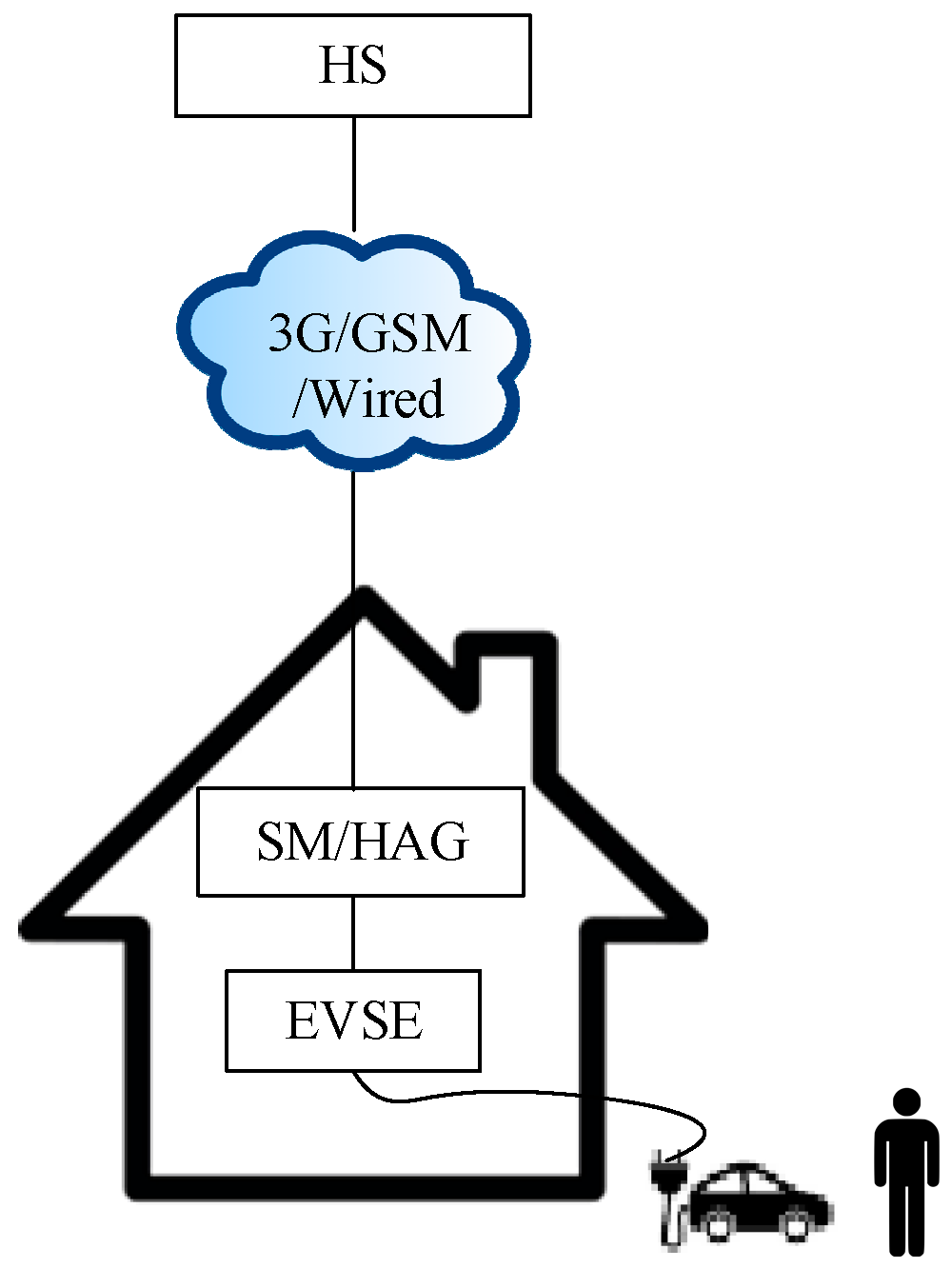
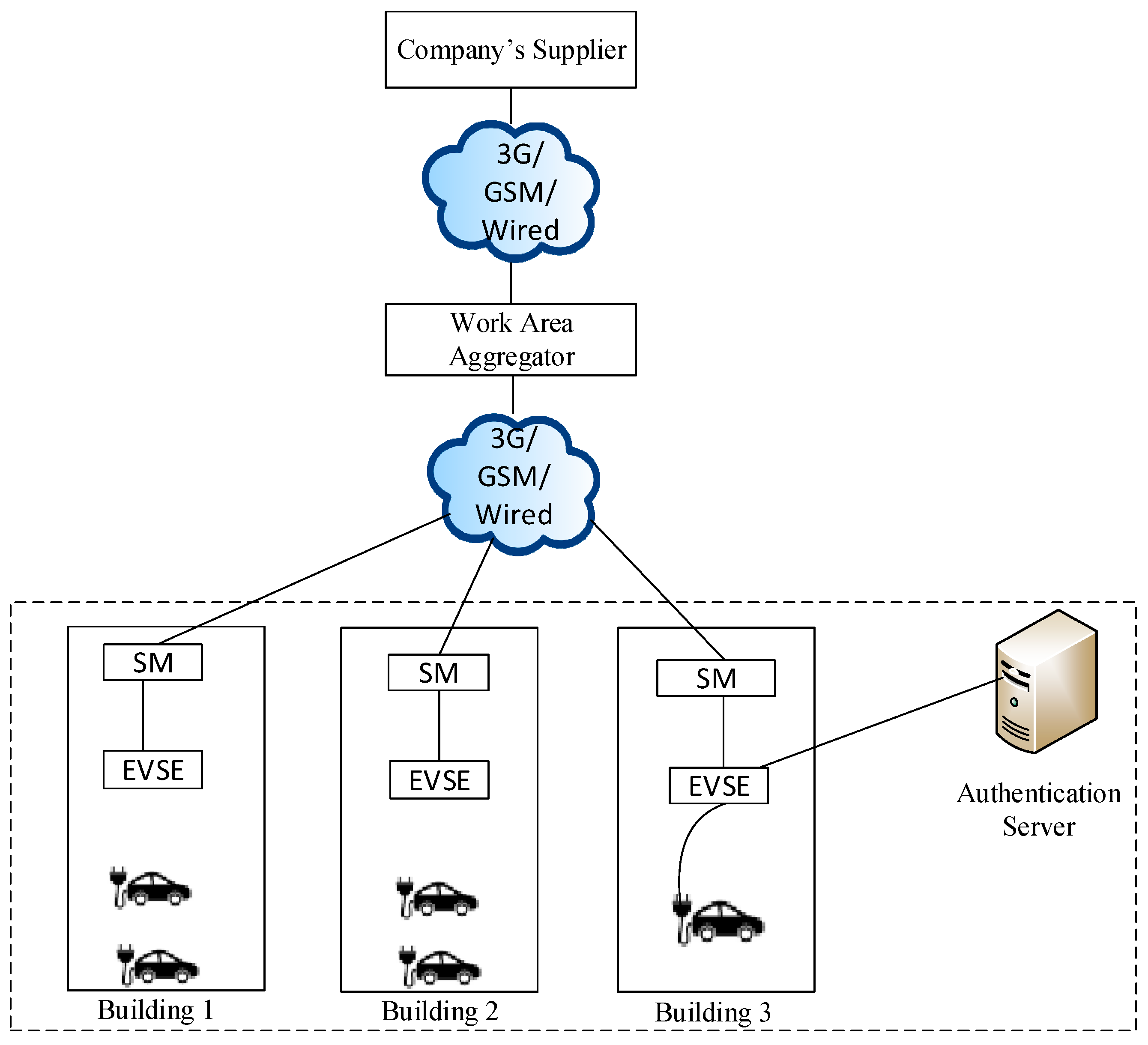
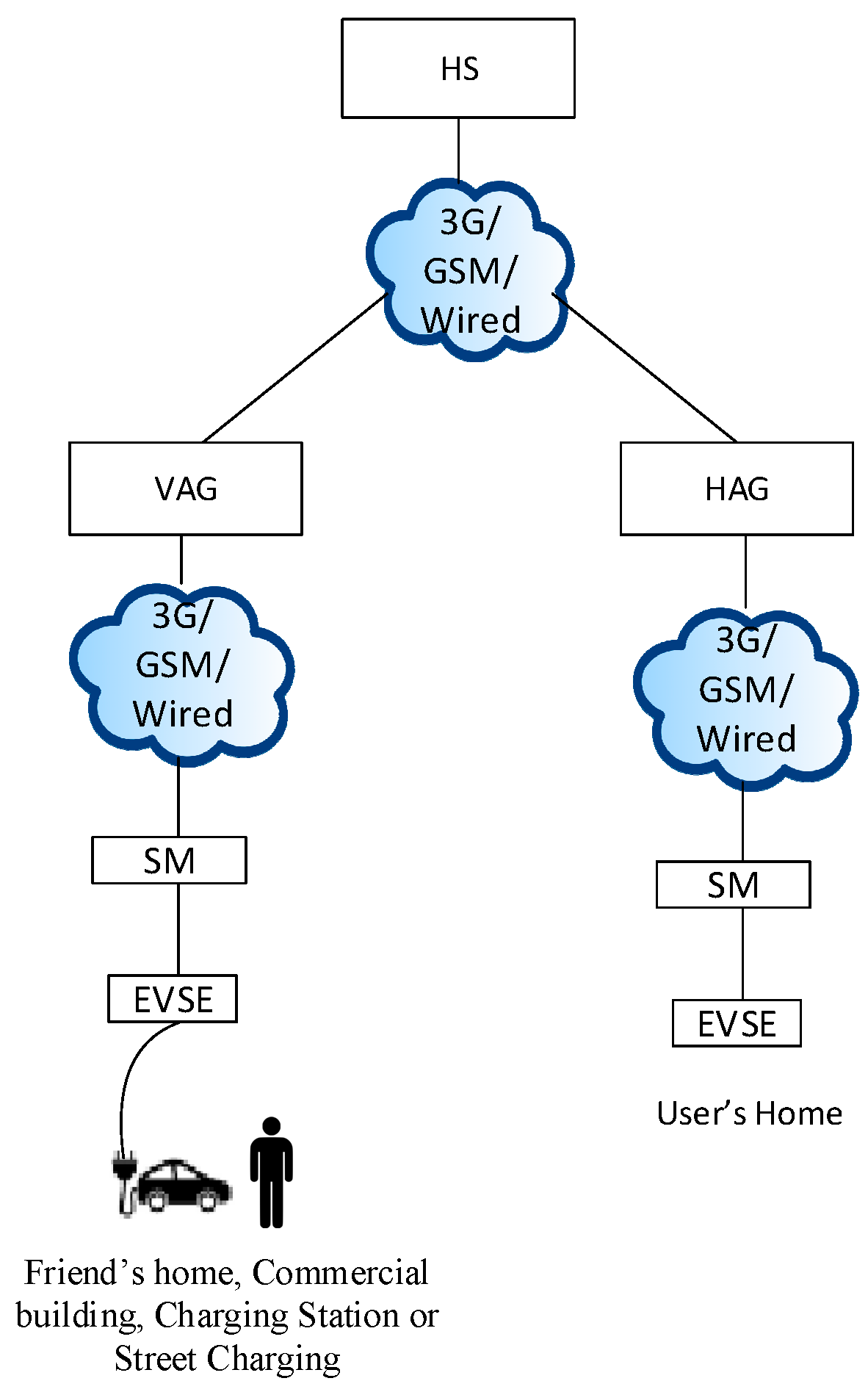
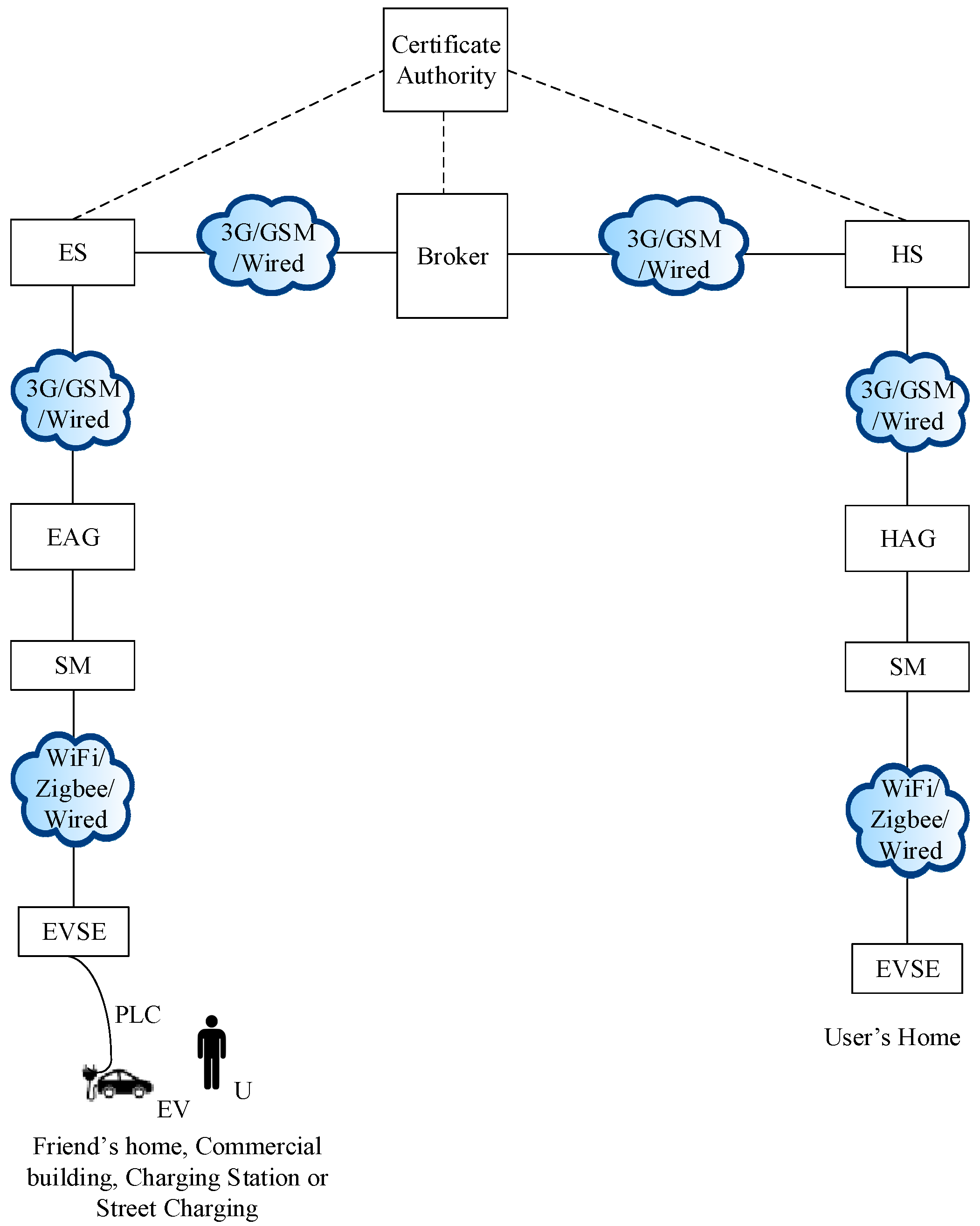


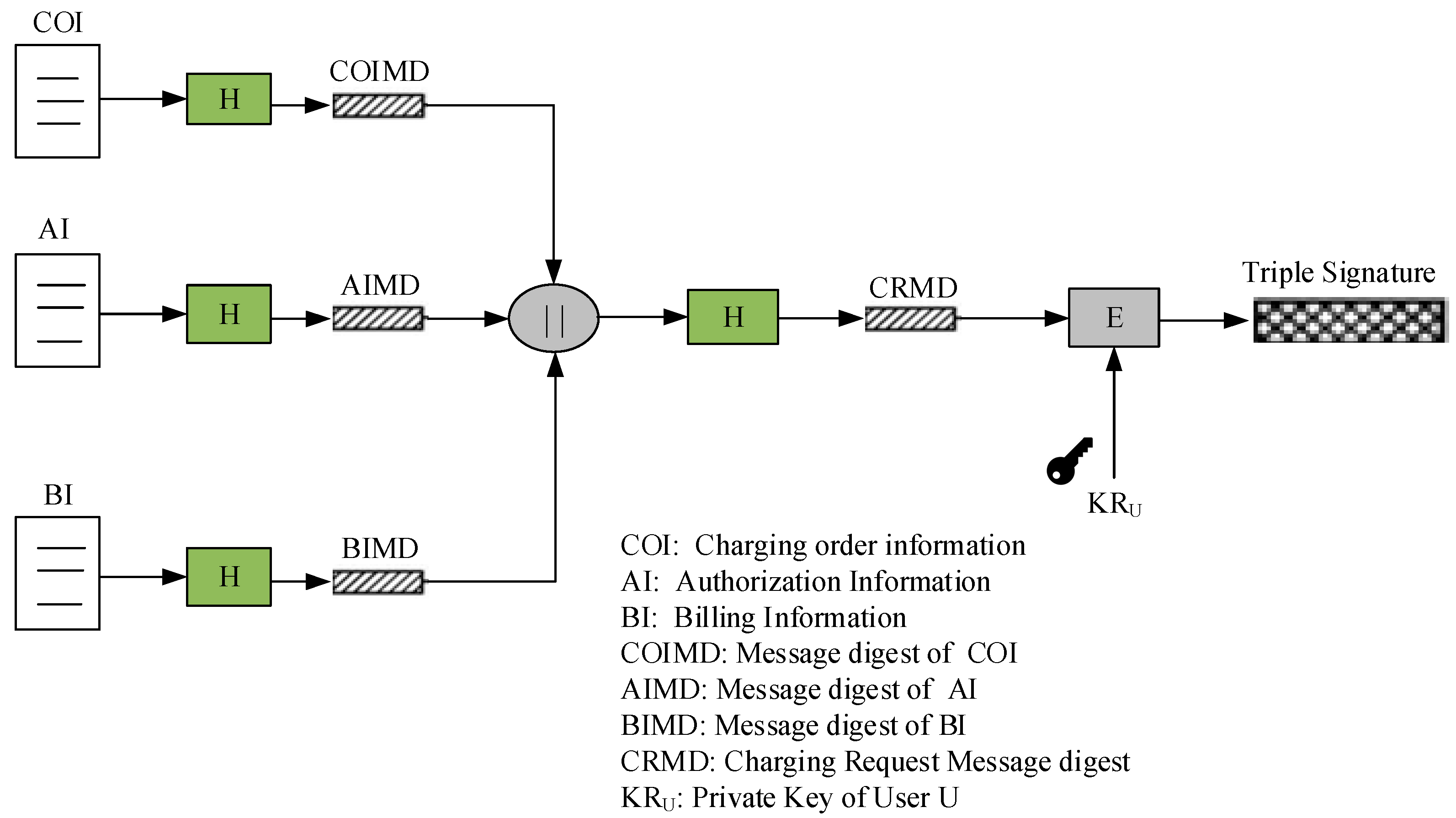
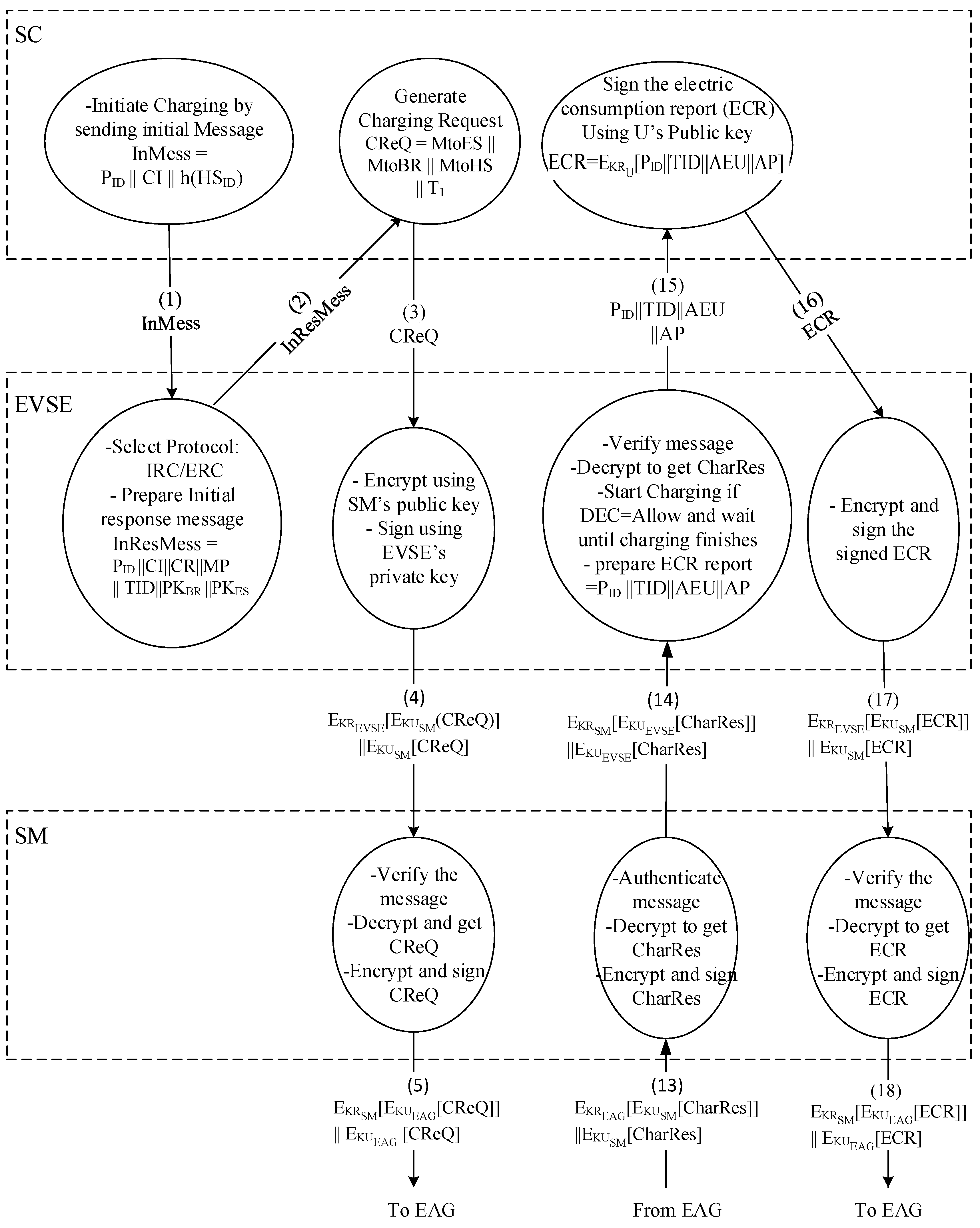
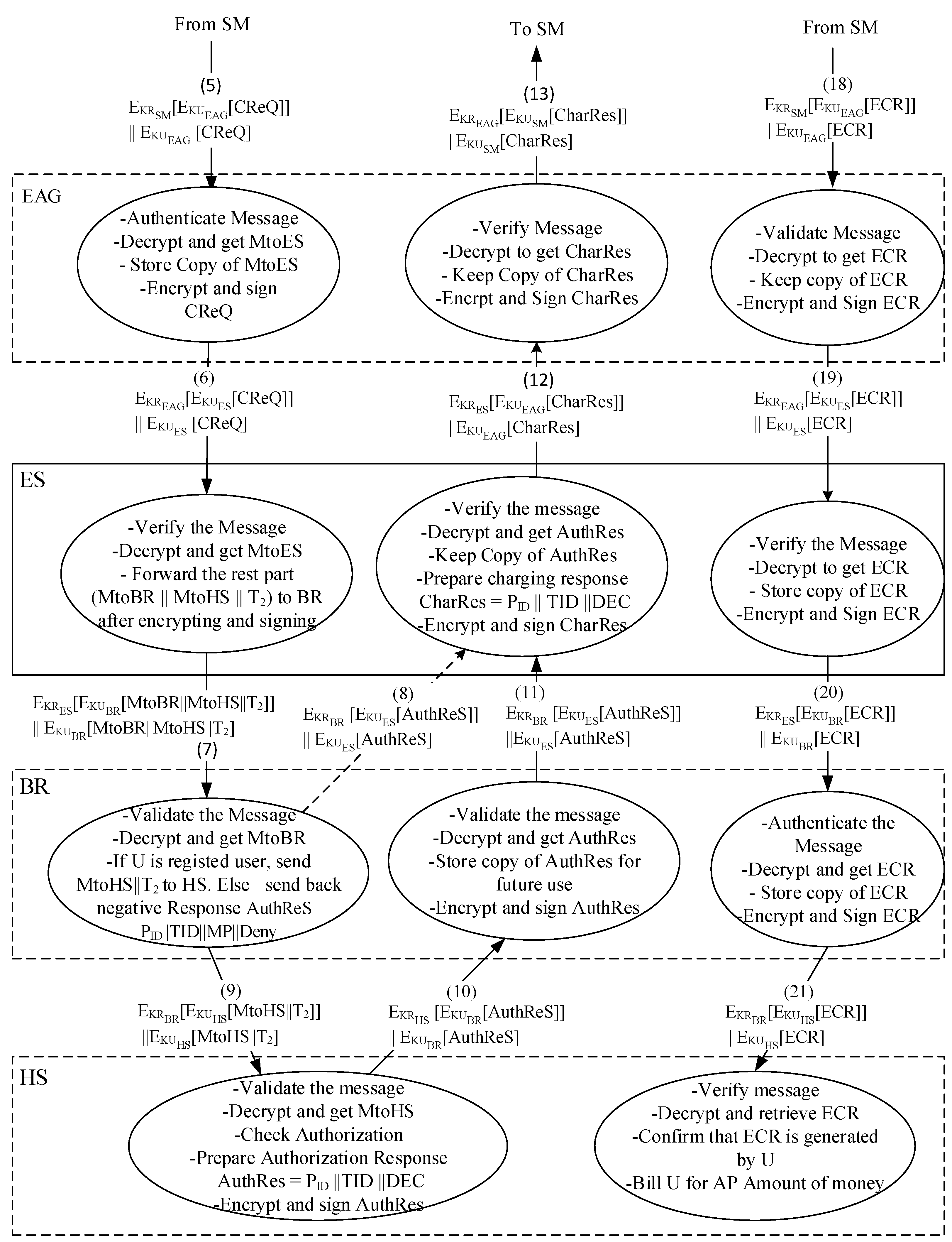
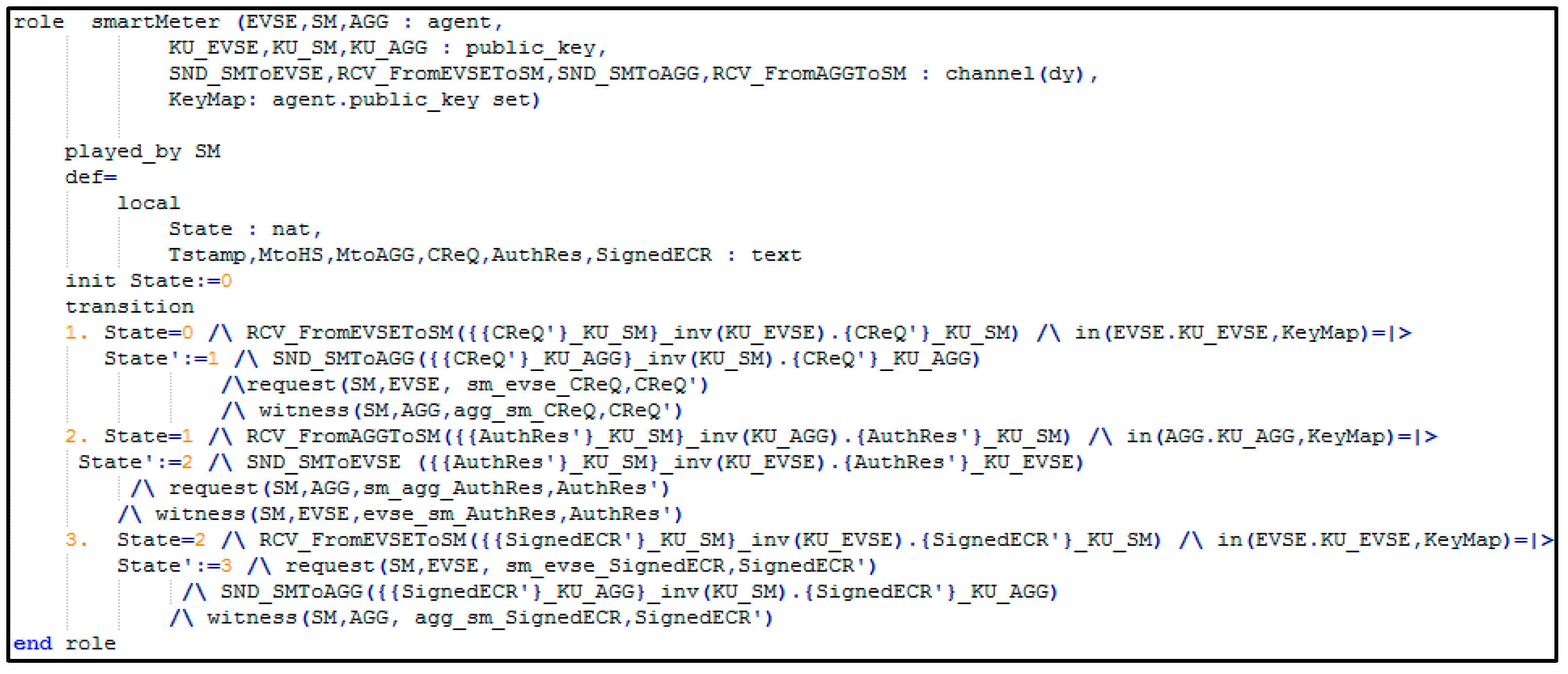
| Charging Location | Charging Mode | Charging Procedure/Method |
|---|---|---|
| Charging at one’s own private location such as his home or office | Privileged user charging | Local authentication |
| Charging at a charging location which is not built for commercial purpose but allows guests to charge for free or by payment. e.g., friend’s house. | Guest user charging |
|
| ||
| ||
| Charging at a charging location built for commercial purpose | Commercial charging |
|
|
| Feature | Covered by |
|---|---|
| Charging mode (Private, Guest, IRC and ERC) | IRC (Guo et al. [9], Liu et al. [10], Chen et al. [11], Saxena et al. [12], Zhang et al. [13], Nicanfar et al. [14], Liu et al. [15], Au et al. [16]), ERC (Mustafa et al. [17]), all modes (Ours) |
| Anonymous user Authentication during IRC | Liu et al. [10], Chen et al. [11], Ours. |
| Anonymous user Payment during IRC | Ours |
| Anonymous user Authentication during ERC | Mustafa et al. [17], Ours |
| Payment Transaction Mechanism during ERC | Ours |
| Anonymous message exchange between suppliers | Ours |
| Authentication (User based, Batch, Mutual, Context-aware) | User-based (Mustafa et. al. [17], Ours), Batch (Guo et al. [9]), Mutual (Saxena et al. [12], Nicanfar et al. [14], Ours), Context aware (Zhang et al. [13], Liu et al. [15]) |
| Supplier (S) | Supplier Billing Account (BA) | Supplier’s Public Key | Registered Users |
|---|---|---|---|
| S1 | BAS1 | KUS1 | {US1-1, US1-2 … US1-X} |
| S2 | BAS2 | KUS2 | {US2-1, US2-2 … US2-X} |
| ⋮ | ⋮ | ⋮ | ⋮ |
| SN | BASN | KUSN | {USN-1, USN-2 … USN-Z} |
| Attack Type | Safe |
|---|---|
| Message confidentiality | ✔ |
| Message integrity | ✔ |
| Impersonation | ✔ |
| Replay attacks | ✔ |
| Repudiation | ✔ |
© 2017 by the authors. Licensee MDPI, Basel, Switzerland. This article is an open access article distributed under the terms and conditions of the Creative Commons Attribution (CC BY) license (http://creativecommons.org/licenses/by/4.0/).
Share and Cite
Shuaib, K.; Barka, E.; Abdella, J.A.; Sallabi, F.; Abdel-Hafez, M.; Al-Fuqaha, A. Secure Plug-in Electric Vehicle (PEV) Charging in a Smart Grid Network. Energies 2017, 10, 1024. https://doi.org/10.3390/en10071024
Shuaib K, Barka E, Abdella JA, Sallabi F, Abdel-Hafez M, Al-Fuqaha A. Secure Plug-in Electric Vehicle (PEV) Charging in a Smart Grid Network. Energies. 2017; 10(7):1024. https://doi.org/10.3390/en10071024
Chicago/Turabian StyleShuaib, Khaled, Ezedin Barka, Juhar Ahmed Abdella, Farag Sallabi, Mohammed Abdel-Hafez, and Ala Al-Fuqaha. 2017. "Secure Plug-in Electric Vehicle (PEV) Charging in a Smart Grid Network" Energies 10, no. 7: 1024. https://doi.org/10.3390/en10071024







